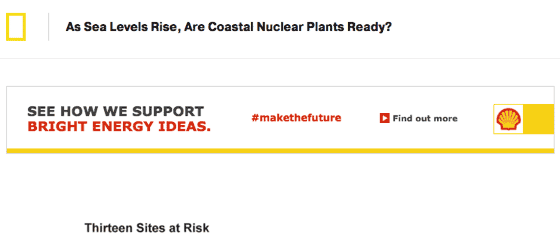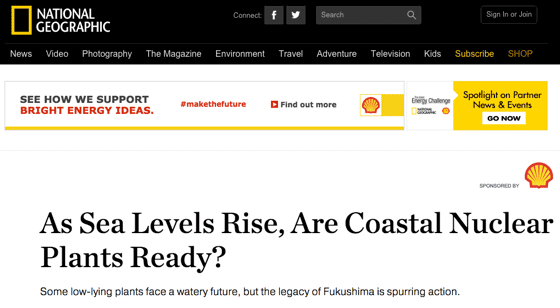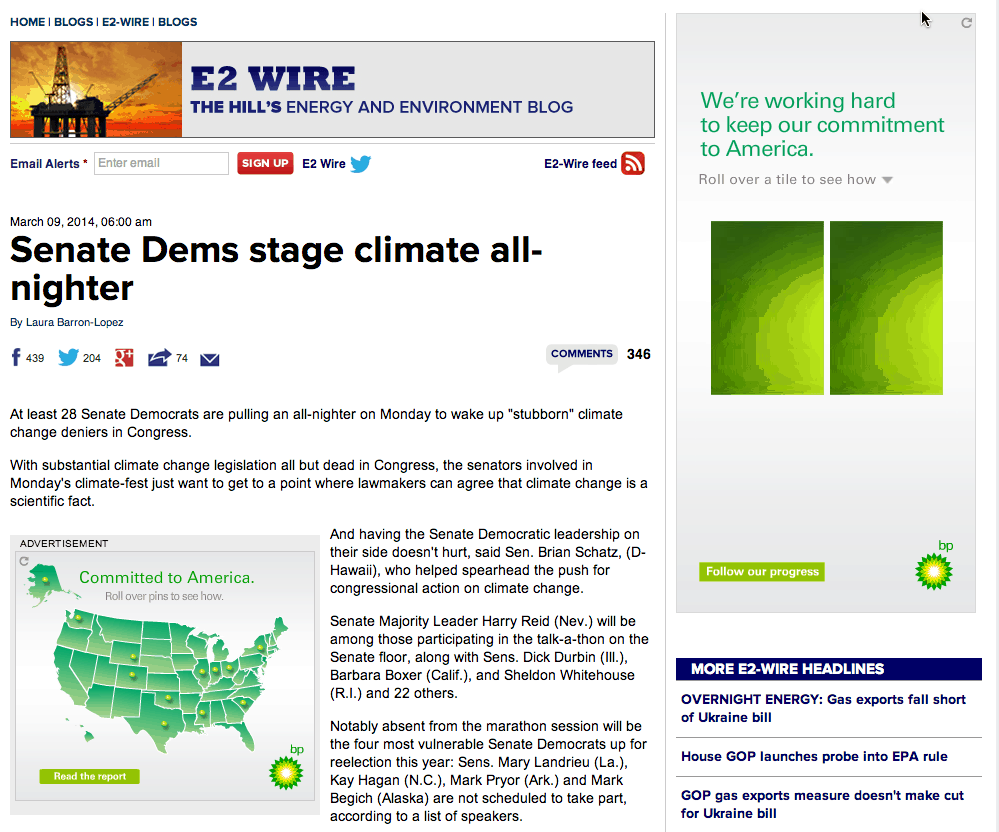Is slowly rising sea level really a concern for nuclear power plants?
Christina Nunez wrote a piece for National Geographic titled As Sea Levels Rise, Are Coastal Nuclear Plants Ready?.
It is a journalistically balanced piece that poses a worrying question about nuclear plant vulnerability. It begins by describing reasons to support nuclear energy along with reasons why some oppose and fear it. It includes critical commentary from a couple of the usual suspects — David Lochbaum of the UCS (Union of Concerned Scientists) and Matthew McKinsey of the NRDC (Natural Resources Defense Council) — along with responses to those comments by Scott Burnell from the NRC (Nuclear Regulatory Commission) and Jim Reilly and Tom Kauffman of the NEI (Nuclear Energy Institute).
However, the critics get both the first and the last word in the article and the very existence of the article in the first place tells readers that this is something that should cause them to be concerned. I’m a strong supporter of the use of nuclear energy as a powerful tool in the battle against climate change. It is frustrating when critics spread the notion that emission free nuclear plants are especially vulnerable to the effects of unmitigated climate change.
The early part of the article includes the following scary tale.
The disaster at Japan’s Fukushima Daiichi showed what can happen when a massive surge of water hits a nuclear plant. Seas of nearly 50 feet washed over it during the 2011 earthquake and tsunami, knocking out the power needed to run its cooling systems. A last-resort bank of batteries lasted only eight hours. As a result, three reactors suffered partial meltdowns and radiation leaked into the air and ocean.
The event gave nuclear a black eye, prompting countries worldwide to take a closer look at their power plants. In the United Kingdom, for example, a pair of reactors were taken offline in 2013 because of concerns that an extreme event could overwhelm its seawall, which was then improved.
Though Ms. Nunez later quotes an industry spokesman saying that nuclear plants have been “battle-tested” and shown their resilience to storms like Katrina and Sandy, the impact is different because it comes from the industry’s media relations person and is not framed as the result of the author’s independent investigation into the performance of hundreds of nuclear plants in the face of dozens of named storms over several decades.
For example, Turkey Point, one of the stars of the article, rode through a direct hit by Andrew with little or no damage. That storm was one of the strongest to ever land in the US and it virtually wiped Homestead, Florida off of the map.
Ms. Nunez did not quote any independent experts that might have helped provide additional perspective on the difference between the effects of a huge, sudden, 45 foot high tsunami and gradual sea level changes that might take place over several decades.
That expert might have helped her to convey more confidence to her readers that the people who are responsible for nuclear plant safety are aware of the issues and taking effective action to protect their valuable assets.
While I recognize that ads on the web are often placed by algorithms based on both story content and visitor interests, I’ve decorated this piece with a couple of the ads displayed when I accessed the article. If these ads are visible to everyone when they visit, I hope they help to ease fears by illustrating the need to approach negative articles with skepticism because of the competitive nature of the energy business.
There are many people, organizations and corporations that have a vested interest in spreading Fear, Uncertainty and Doubt (FUD) about the safety and security of nuclear energy production facilities.
Even those who vociferously proclaim that they are working in the public interest have donors that make it abundantly clear that they are not supposed to encourage the use of nuclear energy. Right, Matthew?




Good thing that coastal coal and natural gas power plants are impervious to slowly rising seas
Quite a nice design feature they accounted for.
🙂
There doesn’t seem to be any algorithm at play here. This particular series is clearly sponsored by Shell. The “Sponsored by Shell” appears on the related articles, as well, including this piece that cites Mark Z. Jacobson.
http://news.nationalgeographic.com/energy/2015/11/151130-how-billionaires-gates-bezos-zuckerberg-could-boost-clean-energy/
Shell sponsorship also appears for this one: http://news.nationalgeographic.com/energy/2015/07/150724-next-gen-reactors-seek-to-revive-nuclear-power/
I wonder: Was Jay A. Percourt associated with Shell some time in his long Petroleum career?
Yes, the adds (bottom banner and sidebar) were there when I booted up the article. BTW…the 5 comments so far are all anti-nuke. I’d post this entire short essay there as a refutation.
David
Was the National Geographic piece really ballanced? Even before nuclear power plants get clobbered by rising sea levels, much of florida is going to become uninhabitable due to rising sea level. Rather than pointing out what will happen to people and their property due to rising sea levels, this piece focuses only on the effects of rising sea levels on nucleaar plants. What is going on here?
First we need to read this paper in the context of the take over of National Geographic by Rupert Murdock. The first thing Murdock did was to replace the old National Geographic team, with a new team ofvright wing propagandists. These propagandists make money for murdock, by selling the pages of National Geographic to various industries who want to twart free markets, by leading readers to believe that the competators of businesses like Shell Oil, are selling damgerous technology. enewables are safe because Shell researchers have determined that renewable will never put the fossil fuel industry out of business.
clearly then the National Geographic, under Murdock, has reached a new low and will most likely never recover its former glory.
I don’t know if they are necessarily right-wing, but they do tend to slant towards anti-nuclear, as does FOX news and others. And news coverage does ignore other more damaging effects of a natural disaster in favor of focusing on nuclear facilities. Just look at the coverage of the Tohoku earthquake and tsunami for that. Its just what the media does, play to fear and emotion rather than objectivity and truth.
I suppose that we can say that Murdock has turned National Geographic into a fossil fuel whore, for reasons of monitary gain and not right wing idiology, but then Murdock believes that information media should be with out ethical rules when it comes to making mobney because that is what his right wing idiology tells him.
Ok…admit it…you spelled it “idiology” on purpose. HA! Busted!
But..uh…didn’t you mean “idiotology”???? Oh no, I forgot, thats the study of all things right wi….uh…oh…never mind.
poa, I have the perfect excuse for my misspelling and typos. I suffer from serious glaucoma. Google Chrom reads Rod’s posts and comments to me. I write responses, but do not see what I write very well. I request my readers indulgence, I am doing the best I can.
Charles…no offense intended. Gawd knows, I make plenty of mistakes here in my posting. My comment was tongue in cheek, insinuating the IDIOcy of some ideologies.
Interestingly, Murdoch’s newspapers here in the UK (the Sun and the Times) do not generally feature columns by climate change sceptics, while other right-wing newspapers do (most notably the Daily Mail).
(Note for US readers — while the UK doesn’t have Fox News or an equivalent, we do have a print media that is far more blatantly partisan than in the US.)
Oh my…Murdoch. Sucks. National Geographic.
Next thing ya know, apple pie is gonna be patented by the Koch brothers.
Good piece, Rod.
I agree that long before the sea level crept high enough to imperil nuclear plant operations that our cities on coasts and river basins would have a lot more to worry about.
I wonder how Nat Geo selects writers for publication and if anyone pronuker went knocklng. Long ago they were very fair and pro-nuclear but ever since they moved onto the tube (and the magazine thinned) the needle moved the other way.
James Greenidge
Queens NY
After taking a minute to look at the US map of reactors it seems most reactors are inland, not on the coast. Some like SONGS are already closed, others like Pilgrim and Oyster Creek have announced closure. It seems that given the gradual nature of sea rise that there would be an announcement. “At the current rate of sea level rise Salem (or other reactor) would need to cease operation in five years.” It seems that the rate of rise may make some sites unusable for future reactors, but it also seems that the rate of rise, coupled with the current age, means that most current reactors will retire before the sea level rise becomes an issue.
@Kevin Krause
The current rate of sea level rise is quite low. If we simply use that experientially determined number, I’d wager that NO U.S. nuclear plants are at risk.
The expectation and desire seems to be that there will be no technological development involving the strong force for the next several hundred years. The proper competitor for oil and gas needs to be sunshine and breezes, in perpetuity.
@Rod I would NOT accept your wager.
Can’t we just shoot all this extra water into space and save these Nukes…….and millions of coastal humans?
Actually, the best place for nuclear power plants to be deployed is on the oceans providing nuclear power plants with a virtually endless heat sink.
Marcel
Unless the laws of competition between capitalists have been “repealed”, I would expect there to be serious R & D toward offshore nuclear plants, as per the MIT efforts first publicized in 2014. The merger of two mature technologies: offshore oil drilling platforms and LWRs, produced on assembly lines in a shipyard, seems like a killer app. No concrete/rebar to speak of; using the ocean as an infinite heat sink and cooling water source; immunity from tsunamis, earthquakes, & volcanoes. Few NIMBY issues or land acquisition costs. Much cheaper to build and decommission (tow it away, etc.) And, adjusts to rising sea levels. One law of capitalist competition is “commercial secrecy”, so if Japan’s biggest shipyard and nuclear power manufacturer, MHI, is working on it; or Hyundai etc. in Korea, or CNNC of China, we may not hear about it. Wait a minute, CNNC has applied to Lloyd’s Register of London for assistance in clarifying maritime regulations for an offshore application of the ACP 100 SMR…maybe this is the camel nose under the tent for going offshore with a version of the ACP 1000 aka Hualong ? (Another intriguing possibility is use of the ACP 100 in ocean freighters, as Cosco was interested in doing a few years’ ago, but that is off topic.)
I think Russian floating reactors will probably dominate the ocean nuclear market in the 2020’s with the MIT type of reactors being built by the US and other nations in the 2030’s.
In the long run, synfuel production from floating nuclear power plants will probably be the most lucrative way to utilize ocean nuclear systems. Shipping ammonia and carbon neutral methanol, gasoline, diesel fuel, and jet fuel from floating synfuel producing facilities using nuclear power would be irresistible commodities.
Such floating synfuel facilities could use the US Navy’s new synfuel from seawater technology to produce carbon neutral fuels or they could simply use the nuclear electricity to pyrolyze garbage transported by garbage freighters from coastal cities, combining the resulting syngas with hydrogen electrolyzed from seawater to maximize synfuel production.
Marcel
Don’t worry, this crazy batch of political wackjobs that are currently tripping over themselves in DC will blow us all to kingdom come way before the oceans have us treading water.
For instance, now the idiots are claiming they can’t account for 18 minutes of time that the San Bernadino terrorists spent after their murderous spree. Are they just retarded up there in DC?? They did what a woman always does when you’re in a hurry……they stopped at a 7/11 so she could pee.
Wow, talk about burying the lede…half the state of Florida, and a huge chunk of coastal Louisiana will disappear under the sea in the +2C scenario, displacing millions of people, and billions of dollars in plant, capital, equipment, homes, etc. Coastal states’ populations and economies will be completely disrupted…and the author is worried about a few power plants that – if the worst came – could simply be shuttered?
This is yet another case where the author writes with the double-secret hidden assumption that nuclear power plants require different standards and special rules relative to everything else – chemical plants, refineries, factories, medical facilities, etc. As if nuclear power is a stick of wet TNT that if we mishandle even slightly, blows up in our hand. Where is the article on how chemical evaporation ponds or fertilizer plants or oil refineries (all of which are near the sea) will be affected by sea level rises? Oh, don’t worry about that…those are conventional industries, so they don’t require special consideration.
Come to think of it, I don’t even understand exactly what the ‘worst-case scenario’ is supposed to be in this article. It’s not like we wake up one day and the ocean is 9 feet higher than the day before…everyone seems to agree that seas are rising at most an inch or two a year. So when the sea level problem becomes impossible to ignore, coastal industries and population centers either build waterproofing + protective berms/seawalls and survive…or they don’t and they don’t. When it becomes clear that we need to move critical items that we don’t want swallowed by the sea (like people, or hospitals, or spent fuel casks), then we…well…move them! This is not an onrushing asteroid where we suddenly discover we have a week to find a way around a planet-wide disaster.
She does recall that what happened at Fukushima was not a storm surge, right?
@swainscheps
sorry – my italics got a little out-of-control.
@swains – I had many of the same thoughts. The close-up of Florida shows everything south of Lake Okeechobee as blue. That includes Miami, Ft Meyers, Ft Lauderdale, and West Palm. Just for a little numeracy:
• Hurricane Andrew resulted in insurance claims totaling $25 Billion
(see http://www.iii.org/sites/default/files/paper_HurricaneAndrew_final.pdf)
• The affected Florida counties total population is about 7 million
(2012 census data from http://www.us-places.com/Florida/population-by-County.htm)
Submerging all of south Florida would destroy property worth thousands of times that damaged by Andrew: 1000 times as much would be something like 25 Trillion dollars. That’s 57,000 times the 2015 budget deficit ($439 billion), and almost half again as much as the total US debt ($18 trillion).
Where are the seven million residents going to go?
Given the magnitude of the losses and population dislocation we can expect from this sea level rise, what is the psychology that leads one to focus on the four reactors in the submerged area?
>>> Where are the seven million residents going to go?
Cuba?